3D printing is a way of fabricating three dimensional solid objects from a digital file. 3D printing is also considered as an additive manufacturing process as the creation of 3D printed objects accomplished using additive processes. Using the additive process, the object is designed by laying down successive layers of material until the object is created. In 3D printing technology objects are created using computer-aided design through solidifying material under computerized control.
Generally, 3D printers use plastic because it is convenient to use and less expensive. 3D is helpful because objects can be made faster. Technology also helps the engineer to test new designs without waiting for someone to execute their designs. 3D printing technology is contrary to subtractive manufacturing which hollows out a piece of material.
Brief History of 3D Printing
Japanese inventor Hideo Kodama had the earliest record of 3D printing through the additive process in 1981. Kodama generated a product using ultraviolet light to harden Polymers and create solid objects. This was the bridge to stereolithography which was invented by Charles Hull and used to create smaller versions of the object so that they could be tested before creating the actual product.
3D Printing in Textile and Fashion
3D printing Technology had a wide presence in various industries like automobile parts, low-cost housing projects, medicine, engineering, science, etc for designing a blueprint and mass manufacturing. The fashion and textile industry is yet to completely implement the technology. The textile industry had fallen behind due to the fact that commercially available synthetic material for 3D printing like polylactic acid is not flexible enough to be used as Textiles or in a garment.
3D printing in textiles is in a planning stage. Trajectory available is collaborating the 3D printed panels with traditional textiles. Designers have explored and came up with garments modeled geometry of sound waves using rubber mesh that let the dress stretch and contracts like a foam mattress. This design gives flexibility 3D printing lacked but the consumer comfort lack in this design.
Thus, 3D printing is confined to its use in jewelry and athletic wear. Brands like Nike and Adidas use this technology for producing effective shoe soles and padding. NASA is also devising the technology to produce 3D printed chain mail material used for protective armors for astronauts.
Applications of 3D Printing In Fashion
- Integral Pieces – 3D printing for additive manufacturing is practically applied to
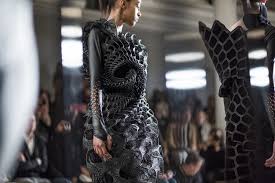 geometric shapes and rigid Creations instead of flexible garments. Dance the first 3D printing work was on import equal pieces presented by the Dutch designer Iris Van Herpen during a ready-to-wear fashion show in 2011. In collaboration with London architect, Herpen produced parts using Selective Laser Sintering 3D printers.
geometric shapes and rigid Creations instead of flexible garments. Dance the first 3D printing work was on import equal pieces presented by the Dutch designer Iris Van Herpen during a ready-to-wear fashion show in 2011. In collaboration with London architect, Herpen produced parts using Selective Laser Sintering 3D printers. - Meshes – Most 3D printed garments are produced using the mesh system. The designer
 Danit Peleg used a home printer to print for her entire graduate collection with no specific Technology. Then she created 3D printed designs including the first fully 3D printed bomber. NASA is also preparing to print 3D mesh coats for cosmonauts.
Danit Peleg used a home printer to print for her entire graduate collection with no specific Technology. Then she created 3D printed designs including the first fully 3D printed bomber. NASA is also preparing to print 3D mesh coats for cosmonauts. - Garment Accessories – 3D printing is now used to prepare ornaments for the traditional textile like the elements of garments including button, rings, or even leather goods used by Exocet Paris bags. Creating 3D printed accessories thermoplastic polyurethane and other polymers like polyamide are used.

- Leather goods – Having its utility in manufacturing of garment accessories, 3D painting also serves as a time saving and cost-effective method for the production of metal parts of leather goods. 3D printing technology not only reduces the cost but also facility production on-demand, on-time testing of new parts, and reduces the waste generation. This technology helps in cost reduction thereby increasing the margins because the material used in the production of leather goods is quite expensive.
- Accessories – 3D printing technology is also used for the production of fashion accessories especially glasses and umbrellas. This technology could be used to design costume jewelry as evident by the alliance between luxury brands and VOJD studios.
- Jewelry– In addition to the production of costume jewelry, additive manufacturing
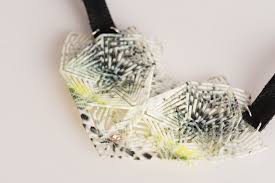 technology can also be used to make the blueprints or a prototype for the complex and technical parts and also for the direct production as used by Gemmyo to produce the simplest part quickly and reducing the storage cost. Initially, all the jewels sold on Gemmyo’s website with computer-generated images, and on receiving orders the jewels were created using 3D printing Technology but now these jewelry are also available in its physical stores.
technology can also be used to make the blueprints or a prototype for the complex and technical parts and also for the direct production as used by Gemmyo to produce the simplest part quickly and reducing the storage cost. Initially, all the jewels sold on Gemmyo’s website with computer-generated images, and on receiving orders the jewels were created using 3D printing Technology but now these jewelry are also available in its physical stores. - Shoes – Brands like Nike, Adidas, Reebok, New Balance, and other major sneaker
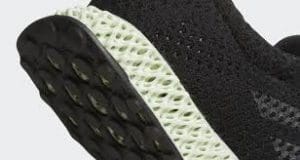 brands are using 3D printing to facilitate customization for their customers. Adidas uses this technique to address the specific needs of each customer by printing souls according to the foot of customers. 3D printed outsole also helps to maximize the performance of the final shoe featuring a more pressurized area and make points with low-pressure mode flexible.
brands are using 3D printing to facilitate customization for their customers. Adidas uses this technique to address the specific needs of each customer by printing souls according to the foot of customers. 3D printed outsole also helps to maximize the performance of the final shoe featuring a more pressurized area and make points with low-pressure mode flexible.
Top 3D Printed Dresses
- Gems of the ocean- Full-length 3D printed gown designed by Samuel Canning and Melinda Looi.

- Synapse Dress – Designer Anouk Wipprecht using Intel’s Edison module that apprehends data and performs various functions.
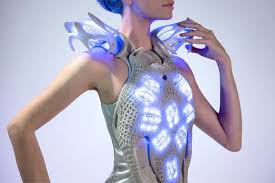
- The smoke dress– Anouk Wipprecht created a dress that releases smoke as someone steps closer to the wearer. This helps the wearer to be alert that someone is stepping into the personal space of the wearer.

- Voltage Collection Dress – Dress designed by Iris Van Herpen has a lace-like texture created with utmost accuracy using Laser Sintering.
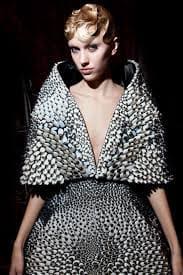
- The spider dress– Anouk Wipprecht fabricated a dress that captures the breathing intensity of the wearer and when the breathing becomes heavy the robotic arms on the dress extend out to defend the wearer.
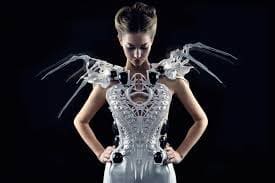
How 3D Printing Is Leading Into a New Era in the Textile Industry
- The advanced technology of 3D printing helps in making the development possible that will revolutionize production and trade in the fashion and textile industry. Garments, shoes, accessories could be designed and created using 3D printing and 4D printing will take this process to a new level with fascinating applications.
- 3D printing in the fashion industry is changing the complete value chain in the apparel industry from designing and prototyping to the finished product and its delivery
- Designers are now using 3D technology to produce cost-effective prototype and samples before the product could go into mass production.
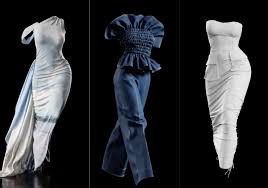
- 3D printing technology has made online shopping easier with a feature to scan the body shape and getting the clothing suggestion.
- Online 3D Catwalk with your own avatar is also possible using virtual reality glasses.
Future of 3D Printing In Textile
Currently, 3D printing technology is used by the designers on the rigid material for producing Meshes, garments, accessories, shoes watch parts, etc but soon this technology could be used on flexible material.
Once 3D printing becomes trendy there will be a situation where anyone can easily use the downloadable patterns and print clothes are their home. This could be used in shops and stores where anyone can walk in and print their fashion items.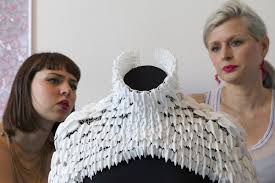
3D printed clothes could have the sensors and other wearable technology that could make the fashionable items smarter along with featuring the privacy and authenticity of the wearer. It is quite possible that even colors of these clothes could be changed according to the particular occasion.
Article Written By-
Naina Rupani, Management Trainee- TVC
FOSTIIMA Business School

